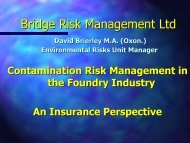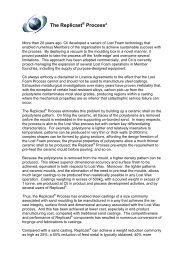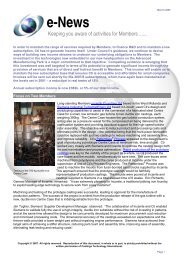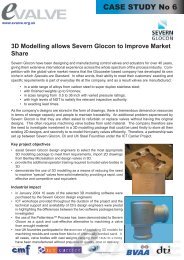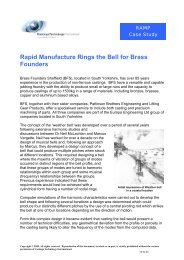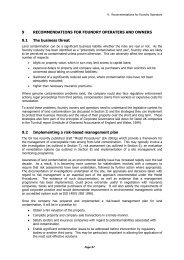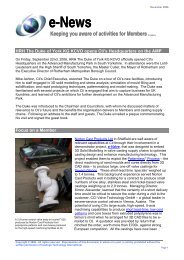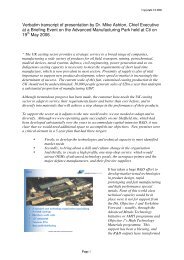Andrew Greenall & Bill Green, Castings Technology International
Andrew Greenall & Bill Green, Castings Technology International
Andrew Greenall & Bill Green, Castings Technology International
You also want an ePaper? Increase the reach of your titles
YUMPU automatically turns print PDFs into web optimized ePapers that Google loves.
LAND CONTAMINATION AT<br />
FOUNDRY SITES<br />
<strong>Andrew</strong> <strong><strong>Green</strong>all</strong> & <strong>Bill</strong> <strong>Green</strong>
Contamination occurs:<br />
From handling raw materials and wastes<br />
From air deposition both on and off the site<br />
Constructing a Conceptual Model will help us to<br />
understand the distribution across the site.
Section through F E Caster and Sons Foundry Ltd, operating since<br />
the early 20 th Century<br />
Starting with a simple cross section we<br />
can begin to develop our model.
For each issue we’ll consider:<br />
Sources<br />
- Scrap, raw materials and waste handling<br />
- air emissions<br />
- made ground (historic)<br />
Pathway<br />
-deposition to ground/surface water<br />
-leaching and migration to water<br />
-contact (human)
Raw materials<br />
Metallic inputs<br />
•Ingots –typically clean, packaged – low potential<br />
•Scrap – may be poorly graded, dirty - high potential<br />
Metals – aluminium, bismuth, boron, cadmium,<br />
chromium, copper, lead, nickel, selenium, brass/bronze.<br />
Non-metals – oil, PAH, PCB, cutting fluids, paints.
Let us put these on our model…<br />
dust<br />
scrap<br />
ingots<br />
Metals<br />
and oils
Mould and coremaking materials<br />
Sands Silica<br />
Chromite<br />
Zircon<br />
– predominantly inert<br />
– high chrome, but in a stable form<br />
– low radioactivity, OK for landfill<br />
Binders <strong>Green</strong>sand – coal dust (metals, PAH, sulphates)<br />
Chemical<br />
– most based round phenolic resins<br />
Phenols soluble, but degrade rapidly<br />
at low concentrations<br />
Others may contain PAH (Urethane)<br />
or acids (Furane)<br />
Early systems organic and unlikely to have left contamination.
<strong>Green</strong>sand<br />
silo<br />
Liquid<br />
binder<br />
system<br />
Sands and binders can leak inside and outside of<br />
foundry during delivery, storage and use
Oils/Fuels<br />
• Coke – Cupolas<br />
• Gas oil – Heating (Furnaces and buildings), vehicle<br />
fuel<br />
• Oils – Lubrication, insulation, hydraulics, quenching<br />
• Solvents – Coatings, paints, release agents<br />
• Chlorinated – degreasing<br />
Others<br />
• Petrol, PCBs<br />
Main contamination potential during bulk transfer and<br />
storage tank leakage – especially underground
Underground diesel<br />
refuelling tank
Wastes<br />
Abatement wastes<br />
• Cupola – dusts and sludges – metals, PAH, (PCDD/F)<br />
• Fettling – metals associated with alloys produced<br />
Melting waste<br />
• Slags – CaO, MgO, metal oxides, alkaline<br />
• Cupola bottom ash – coke dust, metals<br />
• Non-ferrous dross metals, fluorides<br />
Other wastes<br />
• Sands – silica dust, phenol, PAH<br />
• “Empty containers” – resins, oils, solvents etc<br />
• Building Wastes – Asbestos
Waste<br />
sand<br />
Disused sludge<br />
lagoon<br />
Abatement<br />
dust spillage<br />
Leak from<br />
“empty drum
Non-direct pathways<br />
Deposition from air emissions - melting<br />
• Metals melted and their alloy constituents<br />
• Contaminants from scrap – PAH, PCDD/F from<br />
combustion, PCB.<br />
• Refractories, fluxing agents – fluorides and chlorides<br />
Also from<br />
• Finishing, fettling etc – metals and their oxides<br />
• Sand plants, knock out, reclamation – silica, binders,<br />
coal dust.
Current air emissions, as regulated, should not have an<br />
impact - but historically they may have.<br />
Identifying historic deposition<br />
Most impacts will be historic – it can be useful to model<br />
the deposition, thereby allowing a prediction of where<br />
the highest levels may be.
HISTORIC DEPOSITION<br />
12 tonnes/hour cupola,<br />
1400<br />
1200<br />
Tot ug/m2/sPM Cupola 1hr<br />
No abatement,<br />
18 m stack,<br />
12 m building.<br />
1000<br />
800<br />
600<br />
70.00<br />
60.00<br />
50.00<br />
Metres<br />
400<br />
200<br />
0<br />
-200<br />
-400<br />
-600<br />
40.00<br />
30.00<br />
20.00<br />
10.00<br />
5.00<br />
2.00<br />
1.00<br />
-800<br />
Prevailing wind<br />
-1000<br />
-1000 -800 -600 -400 -200 0 200 400 600 800 1000 1200 1400<br />
Metres
Contamination from made ground/relics of mining<br />
activity<br />
As a source;<br />
• metals, ash, clinker, sand, colliery spoil<br />
As a pathway;<br />
• increased porosity<br />
• increased permeability<br />
• un-filled mine shafts provide a direct pathway to<br />
lower strata/groundwater
Groundwater<br />
Made ground<br />
Natural strata<br />
Mineshaft<br />
Groundwater
Conclusion<br />
Sources<br />
Pathways



